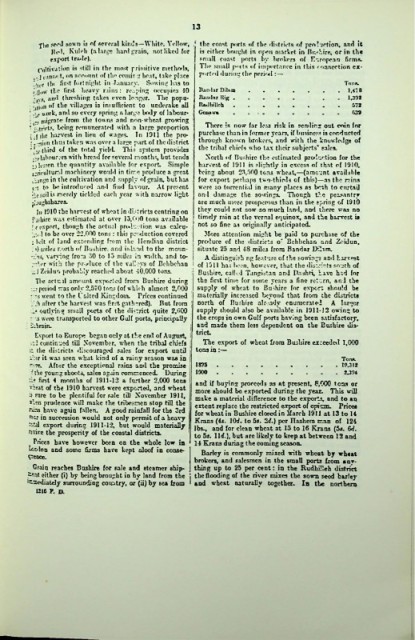Page 285 - 5 Persian Trade rep BUSHIRE I_Neat
P. 285
13
The seed sown is of several kinds—White, Yellow, the coast ports of the districts of promotion, and it
Re-1, Kuleh (a large hard grain, not liked for is either bought in opn market in Rwhire, or in the
export trade). small coast ports by brokers of European firms.
(Cultivation is still in the most primitive methods, The small ports of importance in this connection ex
(„ j lanie t. on nccount of the comir g heat, take place ported during the period :—
_/(l,r |]k first fortnight in January. Sowing lias to Ton*.
i i|,»\v the first heavy rains: reaping occupies 10 ll.in<!.ir Ditnrn 1,478
and threshing takes even longer. The popu- Bainlar Rig . 1,332
jys,
; jijjon of the villages is insufficient to ur.derake all IUdliillch . 572
' work, and so every spring a large body of labour- Gcom G33
r# migrate from the towns and non-wheat growing
• ;.,|r;cts, being remunerated with a large proportion There is now far le?3 risk in sendinz out coin for
ijthc harvest in lieu of wages. In 1011 the pro- purchase than in former years, if business is conducted
•. nidi thus taken was over a large part of the district through known brokers, and with the knowledge of
'‘jo third of the total yield. This system provides the tribal chiefs who tax their subjects’ sales.
;;elabourers with bread for «eveml months, but tends North of Bushirc the estimated production for the
:j lessen the quantity available for export Simple harvest of 1911 is sliuhtly in excess of that of 1910,
.jricultund machinery would in time produce a great being about 23,300 tons wheat,—(amount available
v':angc in the cultivation nr.d supply of grain, but has for export perhaps two-thirds of this)—as the rains
x.:i to lx? introduced and find favour. At present were so torrential in many places ns bcih to curtail
\\isoil Is merely tickled each year w ith narrow light an-1 damage the sowings. Though tie peasantry
^jugbshares. are much more prosperous than in the spring of 1910
In 1910 the harvest of wheat in districts centring on they could not sow so much land, and there was no
f jdiirc was estimated at over 15,OjO tons available timely rain at the vernal equinox, and the harvest is
it export, though the actiul production was calcu- not so fine as originally anticipated.
1 to be over 22.000 tons : this production covered More attention might he paid to purchase cf the
: holt of land extending from the Ilcndian district produce of the districts or Bchbchan and Zeidun,
. 0 uiiles r.orth of Bushire. and inland to the moun- situate 25 and 48 miles frora Bandar Dthm.
•iis, varying frora 30 to 13 miles In width, and to- A distinguish ng feature of the sowing and harvest
. :Vr with the produce of the valleys of Bchbehan i 0f 1911 has Wen, however, that the districts south of
-J Zculur. probably rcaclu-d about 40,000 tons. Bushire, called TangWnn and Dashri, have hid for
The actual amount exported from Bushire during the first time for some years a fine return, and the
peiiod was only 2,570 tons (of which almost 2,000 supply of wheat to Badiirc for export should be
: -s went to the I'aited Kincdoin. Prices continued materially increased beyond that from the districts
_;:h after the harvest was first gathered). But frora \ north of Bushire already enumerated A larger
;» outlying small ports of the district quite 2,000 supply should also be available in 1911-12 owing to
• \s were transported to other Gulf ports, principally the crops in own Gulf ports having been satisfactory,
Lihrain. and made them less dependent on the Bushire dis
Export to Europe began only at the end of August, trict.
i-.} continued till November, when the tribal chiefs The export of wheat frora Bushire exceeded 1,000
it the districts discouraged sales for export until tons in:—
vmt it was seen what kind of a rainy season was in Ton*.
“'-Tv. After the exceptional rains and the promise 1895 19.312
'the young shoots, sales again commenced. During 1900 2J94
first 4 months of 1911-12 a further 2,000 tons and if buying proceeds as at present, 8,COO tens or
rheat of the 1910 harvest were exported, and wheat more should be exported during the year. This will
rare to be plentiful for rale till November 1911, make a material difference to the exports, and to an
•ten prudence will make the tribesmen stop till the
nLis have again fallen. A good rainfall for the 3rd extent replace the restricted export of opium. Prices
for wheat in Bushire closed in March 1911 at 13 to 14
r«-~ in succession would not only permit of a heavy Krans (4s. lOd. to 5s. 2d.) per Ilashern man of 124
:'-tel export during 1911-12, but would materially lbs^ and for clean wheat at 15 to 16 Krans (5s. 6d.
revive the prosperity of the coastal districts. to 5s. lid.), but are likely to keep at between 12 and
Prices have however been on the whole low in 14 Krans during the coming season.
London and some firms have kept aloof in conse- Barley is commonly mixed with wheat by wheat
<P?occ.
brokers, and salesmen in the small ports from any-
Grain reaches Bushire for sale and steamer ship- thing up to 25 per cent: in the RudhiHeh district
?*nt either (i) by being brought in by land from the | the flooding of the river mixes the sown seed barley
immediately surrounding country, or (ii) by sea from ■ and wheat naturally together. In tbe northern
1216 P. D.

